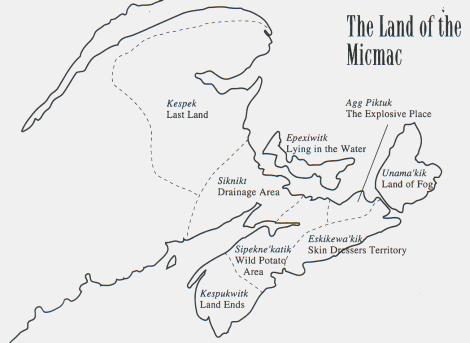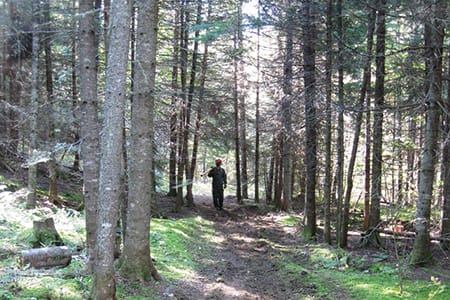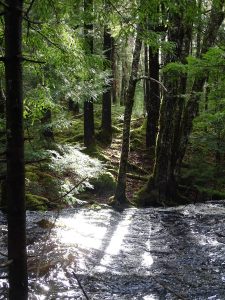
Mi’kmaw-led Conservation Webinar Series A history lesson about Mi’kma’ki from Roger Lewis with the Nova Scotia Museum Sa’qawey Nipukt: Old Forests (audio) We Rise Together Tan Telolti’k: How are we doimg now An Introduction to Indigenous Protected and Conserved Areas (IPCAs) Conservation through Reconciliation Returning to Netukulimk: Mi’kmaq cultural and spiritual connections with resource stewardship and self-governance
The Best of Atlantic Voice: An Interview with Polaris Prize winner Jeremy Dutcher from 2019 Keltic Petrochemical Mi’kmaq Ecological Knowledge Study Puktewei: Learning from Fire in Mi’kma’ki (Mi’kmaq Territory) Also view Links to Mi’kmaw & Aboriginal Theses Available On-Line The western idea of private property is flawed. Indigenous peoples have it right. Mi’kmaq History Month Reading List Articles by Micael William McDonald on Mi’kmaw history and culture on the Nova Scotia Advocate Ta’n Weji-sqalia’tiek: Mi’kmaw Place Names Digital Atlas and Web Site |
Gifts to a Future World: Conversations with Woodland Owners in Nova Scotia
Dalhousie Univeristy MES thesis by Andrew Kekacs, 2017
Private, non-industrial woodland owners provide more than half of the timber used by Nova Scotia’s forest-products industry. Research, however, suggests that many of these owners do not consider the income from timber sales to be their primary reason for owning woodland. This study aimed to reach a holistic understanding of their attitudes and motivations using walking interviews on the owners’ woodlands and a grounded theory approach to analysis. Forest landowners interviewed for this research were most concerned with the conservation – and ultimately the conveyance – of values that provide them with no immediate economic returns. The high value placed on these “gifts to a future world” offers a new way to think about the design of programs meant to encourage active management of private forestland.

NSDNR Minister MacDonell at rally on oct 29, 2010: “There’s gonna be a reduction in clearcutting in Nova Scotia.” View video
Restoring the Health of Nova Scotia’s Forests
A panel of expertise report on forests by Bob Bancroft and Donna Crossland to the steering panel for the Nova Scotia Natural Resources Strategy 2010 process. This report was widely applauded, the Steering Panel adopted most of their recommendations, and then NDP Minister of Natural Resources John MacDonell promised fundamental change. He released a set of “strategic directions which included a commitment to “Reduce the proportion of wood harvested by the clear cut method to no more than 50% of all forested lands over a five-year period”. Within months, however, Premier Dexter shifted MacDonell to another Dept. and the Bancroft/Crossland Report was tacitly shelved in favour of an alternative, industrial forestry-oriented Report by Jon Porter. The province was still committed to the 50% target for clearcutting but introduced a definition of clearcutting that effectively allowed a lot of what is functionally a clearcut not to be counted as a clearcut. Four years later the new Liberal government hired Jon Porter as the executive director of the NSDNR’s renewable resources branch. In August of 2016 (the year clearcutting was to have been reduced to 50% of all cuts), the province issued a five-year Progress Report on the 2011-2020 Natural Resources Strategy in which they announced that the 50% target was irrelevant because “We have now developed tools that ensure that all harvest treatments are aligned with the nature-based requirements of Nova Scotia’s lands.” The return to same old same old was complete. Regardless of the history subsequent to the Bancroft/Crossland report, their report still says a lot about the current state of our forests (just add 6 more years of extensive clearcutting and the “biomess”) and where we should be headed. Also see the Research Addendum. See also Natural Resources Strategy Summary by Richard Beazley (2017); When is a Clear Cut not a Clear Cut? (Miles Howe for Halifax media coop nov 25, 2011); comments by Donna Crossland Apr 13, 2011 .
Comments on the Phase II Recommendations related to Forestry and a Critique of the Review of those Recommendations by Dr. Robert G. Wagner
David G Patriquin, July 27, 2010. The Forest Products Association of Nova Scotia (now known as Forest Nova Scotia) did not like the conclusions of Restoring the Health of Nova Scotia’s Forests (above), and hired* Dr. Robert G. Wagner, Director of the University of Maine’s School of Forest Resources, to review it. He submitted a confidential report titled Review of Reports and Recommendations Relating to Forests/Forestry as Part of Phase II of Nova Scotia’s Natural Resources Strategy Development Process on July 7, 2010, which was forwarded to government.** I was given a copy of that report and reviewed the review which I also submitted to government and made public. Unfortunately Forest Nova Scotia has still not made Wagner’s report public, a sad comment in itself as was Wagner’s report.
*Reportedly paid in the 6-digit range
**While confidential, it was, apparently, used as the basis of FPANS’s PR campaign with members to cast the Natural Resources Strategy Phase II Recommendations as “not based on credible science and come from people who would prefer to see our industry die”. View the EAC Response to Forest Industry Campaign against Steering Panel Report (July 11, 2010). Macdonnell was evidently not persuaded by the numerous letters he received (re comments on Oct 29, 2010), but he didn’t have Premier Dexter’s back and was moved to another portfolio in early 2011.
In Search of Compass and Gyroscope: Where were Adaptive Management and Principled Negotiation in Nova Scotia’s Forest-Strategy Process
By Peter Duinker, Dalhousie Law Journal 70, p 55-70 (2012). (Only the abstract is available to the public). Prof Duinker is highly critical of the “the process used to develop Nova Scotia’s Natural Resources Strategies of August 2011, specifically the forest strategy” and cites the Wagner review (see above) as evidence that it didn’t work. It is remarkable to me that an academic would cite an unpublished and inaccessible document commissioned by a party that clearly did not like the outcome of the process as an “independent peer review” and cite it so uncritically as evidence that process did not work, a point apparently missed by any reviewers. I wouldn’t list it here were it not that Prof Duinker is one of the experts hired by the Independent Review of Forestry in NS that is being conducted Aug 30 2017-Feb 28, 2018 (see Post of Nov 29, 2017 for some further comments).
 Goin’ To The Woods
Goin’ To The Woods
Article by Cary Rideout in November/December 2011 issue of Saltscapes. “In his day, Father says, they didn’t cut anything “smaller than 10 inches on the stump.” That meant that the logging company could cut the area again in about 15 years.” The article includes 7 Tips for Managing Small Woodlands by Bob Bancroft.
Nova Scotia forestry: seize the moment
Op-ed by Wade Prest, July 19, 2012.”Nova Scotians have a window of opportunity to change the way we use the forest, to set the stage for better times for our children and grandchildren.” Unfortunately, it was not to be under the NDP government of Darrell Dexter, but the choices remain.
Push reset button on N.S. forestry policy
Dale Smith in CH, Jul 8, 2016. “There is an old saying about not being able to see the forest for the trees, in essence that details can obscure the big picture…” Read more
Give our forests back to the people
Bob Bancroft in CH, Mar 4, 2016.”Centuries ago, Maritime forests loomed over freshwater shores; tall, vibrant, thick and strong…More than 40 per cent of the operable forest in Nova Scotia has been clear-cut in the last 25 years. Many Nova Scotians understand that clear-cutting and other large-scale methods of forest flattening cause drastic environmental changes.” Read more.
Stopping ‘fibre panic’ and reforming forest policy in Nova Scotia
Ralph Surette in rabble.ca, Sep 22, 2014
“There have been calls for “reform” of DNR all along but nothing happens. The department remains more of an arm of industry than of government. Nothing short of breaking up this granitic monolith will do anything.” Surette was particularly concerned in 2014 about western Crown lands which are “the last great wood basket” not committed to pulp companies.. By 2016, that was no longer true.
Guysborough County forester worries about fate of areas like Giants Lake
CBC news Jan 22, 2016. Is there enough land in northern Nova Scotia to supply two pulp mills, the new biomass boiler and allow for high-value forest management? NSDNR thinks so, but Daniel George and Russell Huntington think not.
The Witness Trees
CBC Ideas, April 18, 2014. “Henry Wadsworth Longfellow’s epic poem Evangeline begins with the words “This is the forest primeval”. Longfellow was talking about the rich Acadian forest, and was taking a little poetic license. In fact, settlers and boat-builders had already pillaged those forests. They were later altered again and again as the pulp and paper industry flourished. Some wonder whether those forests of 500 years ago can be regrown. Are our forests fiber mines or recreational playgrounds? Are they an economic engine or necessary for our environmental health? And are they essential, as some neuroscientific research is suggesting, to our mental well being? IDEAS contributor Dick Miller re-imagines the forest of the future.”
We need a forest land policy that values, uses diversity
Op-ed by Luke L Batdorf, CH 22 Sep 2016. An elder speaks.”The elephant died first, the big hardboard business died later and now Bowater, too, is dead. With current policy and whole-tree harvesting, along with a retreat back into a weak quasi-clear-cutting forestry, our forests will die. Arguably, the big mills added economic gain to communities, but there is no hard quantifiable evidence to prove this. Rural communities are emptying of people, just as our forests are emptying of trees.”
TOWARD SUSTAINABLE FORESTRY A POSITION PAPER
NS Dept. of Natural Resources, Working Paper, 1997-01. “…The Department also proposes making data and information on forests and forestry more readily accessible and available in future, and that there should be an ongoing process for public consultation and input on forestry issues.”
Forestry : report of the Nova Scotia Royal Commission on Forestry
Nova Scotia Royal Commission on Forestry, 1984, 100 pages. ‘Cannot find full text online.
Fight for forestry
Website created 2020-02-19 (info from www.whois.net/). From the homepage:
“It’s time to fight for forestry. The forced closure of the Northern Pulp mill is devastating rural Nova Scotia. Hundreds of jobs have already been lost and thousands more are threatened. Forestry related businesses are laying people off, trimming production, and not investing in new equipment. Many forestry operations will fail and shut down. The fear in forestry families and communities is real. It’s time to fight back. The landowners, forestry companies and workers have had enough! We are the foresters, harvesters, truckers, sawmill workers, silviculture and road experts that make healthy forestry possible.
For decades, those of us working in the forestry sector believed that our elected representatives supported what we did, understood its importance to maintaining healthy forests and appreciated the massive contribution modern forestry makes and should continue to make to the economy of rural Nova Scotia. The Northern Pulp closure is a wake-up call. We must fight for our sector and defend what we do or be meek and get pummelled.
Fight for Forestry is joining the public debate. We will speak the truth and name names…”
View Letters to the Editor for some detailed comments

